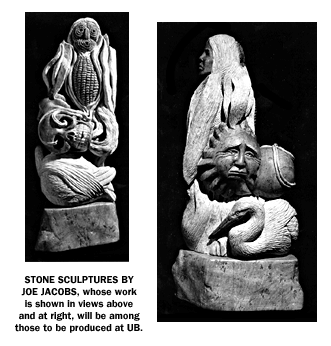
PHOTOS BY PATTY WALLACE

By PATRICIA DONOVAN
News Services Editor
The first project on line is an edition of bronze castings of a small and delicate stone sculpture by Joe Jacobs, one of North America's most respected Native-American artists. His work can be seen on the frieze of the Museum of Civilization, Canada's premier Native American art center, operated by the Department of Indian and Northern Affairs Canada in Hull, Quebec.
The casting project, funded by Anderson, is now under way at the institute under the direction of Tony Paterson, UB professor of art.
Anderson also will fund a 30-foot enlargement of the work for permanent exhibition on the Tuscarora Reservation. A special enlarging machine purchased by him and already in place on the reservation will be used. Paterson and the Casting Institute will assist with the lengthy process.
Anderson has a facility that will house the large Jacobs work. He also hopes to establish a gallery of native art on the reservation, as well as an art foundry to help promote self-sufficiency for his nation. The foundry, he said, will train Tuscarorans in new skills so that they may continue to assist Jacobs and other Tuscaroran artists.
Jolene Rickard, a Tuscaroran native and assistant professor of art and art history at UB, has written and lectured widely on the aesthetics of native art. She points out that although Americans are familiar with art produced by American Indians of the southwest, little is generally known about the art of the Iroquois nations. Anderson, she said, has expressed interest in helping to develop an awareness of this work on the American scene.
In producing the small casts, Paterson faced a challenge.
Like much of Jacobs' art, the original work is marked by delicate and complex carvings of native motifs into soft stone in a way that accentuates the quality of the material. In order to cast it in bronze, Paterson had to make a flexible mold that would not stain the porous stone or break the delicately carved original.
He used a high-quality rubber and blanket mold technique that picked up the delicate tracings but preserved the integrity of the original work. Students in the Sculpture Program working under the auspices of the Casting Institute are learning this new technique by working with the Jacobs sculpture.
The University at Buffalo has longtime affiliations with the artists and scholars of the Tuscaroran community, along with members of other tribes of the Iroquois nations.
Rickard is a noted photographer and specialist in 19th- and 20th-century art. She teaches courses in visual theory, aesthetics and criticism, and her photography has appeared in museums and galleries throughout the country. A popular lecturer, she regularly presents invited talks at major universities.
Tuscaroran artist Richard Hill, assistant professor in the Department of American Studies, is noted for his work as a curator of Native-American art. He has long been a principal in the development of the National Museum of the American Indian, a division of the Smithsonian Institution, and currently is curating three important exhibitions of American Indian art in the U.S. and Canada. He is also at work at UB on an electronic library of contemporary Indian thought.

PHOTOS BY PATTY WALLACE